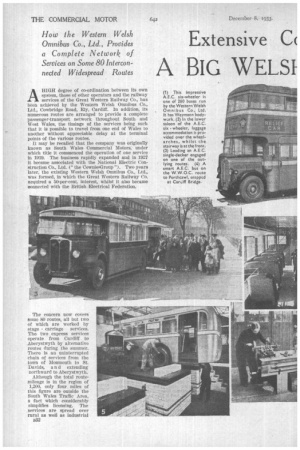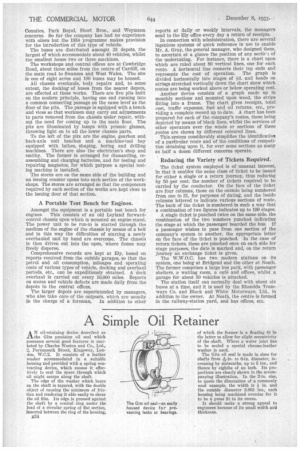Extensive C( ordination in
Page 46

Page 47

Page 48

If you've noticed an error in this article please click here to report it so we can fix it.
A BIG WELSI
BUS SYSTEM
AHIGH degree of co-ordination between its own system, those of other operators and the railway services of the Great Western Railway Co., has been achieved by the Western Welsh Omnibus Co., Ltd., Cowbridge Road, Ely, Cardiff. In addition, its numerous routes are arranged to provide a complete passenger-transport network throughout South and West Wales, the timings of the services being such that it is possible to travel from one end of Wales to another without appreciable delay at the terminal points of the various routes.
It may be recalled that the company was originally known as South Wales Commercial Motors, under which title it commenced the operation of one service in 1919. The business rapidly expanded and in 1927 it became associated with the National Electric CartRtruction Co., Ltd. (" the CowniefGroup "). Two years later, the existing Western Welsh Omnibus Co., Ltd., was formed, in which the Great Western Railway Co. acquired a 50-per-cent. interest, whilst it also became connected with the British Electrical Federation.
The concern now covers some 80 routes, all but two of which are worked by stage carriage services. The two express services operate frau!! Cardiff to Aberystwyth by alternative routes during the summer. There is an uninterrupted chain of services from the town of Monmouth to St. Davids, an d extending northward to Aberystwyth.
Although the total routemileage is in the region of 1,200, only four miles of this figure are outside the South Wales Traffic Area, a fact which considerably simplifies licensing. The services are spread over rural as well as industrial B.32 districts, so that the company takes a fair share in the work of providing facilities that are not of financial value, but are of considerable local public importance. Particularly is this the case in West Wales, where, to all intents and purposes, buses are the only means for public transport.
The co-ordination of services, to provide a complete network over its particular area, has been one of the principal objects of the management in the development of the company.
Extensive through-booking and inter-availability facilities are offered, in which a large number of operators, including local authorities, and the G.W.R. participate. In the majority of cases of this nature, there is individual adjustment of revenue, but a successful pooling scheme on a mileage basis is in force between the "Western Welsh " and Red and White Services, Ltd., and the latter's associated companies.
The co-operative arrangements with the railway company are in effect principally on the main road from Cardiff to Neath and in the Bridgend Valleys, where they are well patronized. Traffic management is in the hands of Mr. W. T. James.
The fleet, which is tinder the control of Mr. A. Dimmock, chief engineer, who was formerly with the Potteries Electric Traction Co., Ltd., in a similar capacity, nuinbers 260 buses of A.E.C., Guy, Leyland and Maudslay makes, with a few small Thornycrofts. All but 16 of these vehicles are single-deckers, the double deckers being A.E.C.s and Leylancls. A -wide variety of makers has supplied the bodies, including the Brush, Buckingham, Leyland, Metcalfe, Northern
Counties, Park Royal, Short Bros., and Weymann concerns. So far the company has had no experience with oilers but the 1934 programme makes provision for the introduction of this type of vehicle.
The buses are distributed amongst 23 depots, the largest of which accommodate about 40 vehicles, whilst the smallest house two or three machines.
The workshops and central offices are at Cowbridge Road, about three miles from the centre of Cardiff, on the main road to Swansea and West Wales. The site is one of eight acres and 100 buses may be housed.
All chassis overhauls, body repairs and, to some extent, the docking' of buses from the nearer depots, are effected at these works. There are five pits built on the modern principle, having one end running into a common connecting passage on the same level as the floor of the pits. The passage is equipped with a bench and vices so that workmen may carry out adjustments to parts removed from the chassis under repair, without the need for coming up to the main floor. The pits are illuminated by lamps with prismic glasses, throwing light on to all the lower chassis parts.
To the left of the pits are the engine, gearbox and back-axle unit benches and a machine-tool bay equipped with lathes, shaping, boring and drilling machines. There are also the electrician's shop and smithy. The former is arranged for dismantling, reassembling and charging batteries, and for testing and repairing magnetos, for which purpose a special testing machine is installed.
The stores are on the same side of the building and an issuing counter opens into each section of the workshops. The stores are arranged so that the components required by each section of the works are kept close to the issuing door of that section.
A Portable Test Bench for Engines.
Amongst the equipment is a portable test bench for engines. This consists of an old Leyland forwardcontrol chassis upon which is mounted an engine stand. The power unit to be run-in is started through the medium of the engine of the chassis by means of a belt and in this way the difficulties of starting a newly overhauled unit by hand are overcome. The chassis is then driven out into the open, where fumes may freely disperse.
Comprehensive records are kept at Ely, based on reports received from the outside garages, so that the petrol and oil consumption, mileages and operating costs of various types of vehicle, docking and overhaul periods, etc., can be expeditiously obtained. A dock overhaul is carried out every 10,000 miles. Reports on stores and vehicle defects are made daily from the depots to the central offices.
The larger depots are superintended by managers, who also take care of the outposts, which are usually in the charge of a foreman, In addition to other reports at daily or weekly intervals, the managers send to the Ely office every day a return of receipts. In connection with administration, there are several ingenious systems of quick reference in use to enable Mr. A. Gray, the general manager, who designed them, to ascertain at a glance the position of any sectic'i of the undertaking. For instance, there is a chart upon which are ruled about 80 vertical fines, one for each route. A horizontal line connects their top ends and represents the cost of operation. The graph is divided horizontally into stages of id. and beads on strings stretched vertically down the chart show which routes are being worked above or below operating cost. Another device consists of a graph made up in monthly sections and mounted upon wood, the strips fitting into a frame. The chart gives receipts, total cost, traffic expenses, fuel and oil returns, etc., providing a complete record up to date. A chart has been prepared for each of the company's routes, these being depicted by means of black lines, whilst the services of other operators over the whole or sections of these routes are shown by different coloured lines. This system considerably simplifies the identification of a particular route and of the conditions of competition obtaining upon it, for over some sections as many as half a dozen different concerns operate.
Reducing the Variety of Tickets Required.
The ticket system employed is of unusual interest, In that it enables the same class of ticket to be issued for either a single or a return journey, thus reducing by 50.per cent. the number of tickets required to be carried by the conductor. On the face of the ticket are four columns, those on the outside being numbered from one to 31, for purposes of dating, and the inside columns lettered to indicate various sections of route. The back of the ticket is numbered in such a way that a combination of two figures indicates up to 199 stages.
A single ticket is punched twice on the same side, the combination of the two numbers punched indicating the stage at which the passenger boarded the bus. If a passenger wishes to pass from one section of the company's system to another, the appropriate letter on the face of the ticket is punched. In the case of return tickets, these are punched once on each side for stage purposes, the date is marked and, on the return journey an exchange ticket is given.
The W.W.O.C. has two modern stations on its system, one being at Bridgend and the other at Neath. The former comprises a large bus park, with passenger shelters, a waiting room, a café and offices, whilst a garage for about 50 vehicles is attached.
The station itself can normally deal with about six buses at a time, and it is used by the Rhondda Tramways Co. and Black and White Motorways, Ltd., in addition to the owner. At Neath, the centre is formed in the railway-station yard, and has offices, etc.




























































































